So Many E-mail Clients but One Clear Choice
Although they're not as plentiful as they used to be, there's no real shortage of e-mail clients. Outlook and Outlook Express, of course, are in widespread use and Thunderbird (both the Mozilla and Eudora variants) are popular. But many more are available. Whenever I look at the others, I wonder why The Bat isn't used by more people in the United States.
When I said "no real shortage", here's what I meant: HTML e-mail (Apple Mail, Balsa, Becky!, Bloomba, Citadel, Claris Emailer, Claws Mail, Courier, EmailTray, Eudora, Forté Agent, Foxmail, IncrediMail, KMail, Lotus Notes, Mail, Microsoft Office Outlook, Modest, Mozilla Thunderbird, Mulberry, Novell Evolution, Novell GroupWise, Opera Mail, Pegasus Mail, InScribe, SeaMonkey Mail, Sylpheed, Sparrow, Spicebird, The Bat, Windows Live Mail, & YAM), Text-based e-mail (Alpine, Cone, Elm, Gnus, mailx, MH, Mutt, Pine, Turnpike & other Unix/Linux based variants), and Web-based e-mail (24SevenOffice, Alpine, Bongo, Citadel, Google, Horde IMP, Hula project, Kerio WebMail, OpenGroupware Webmail, RoundCube Webmail, SquirrelMail, WebPine, Yahoo, & Zimbra). And I'm sure that I've missed some, even with Wikipedia's help.
The Bat (or as the developers style it, "The Bat!") has been my preferred e-mail program since sometime in the 1990s when I discovered it. In the past 10 to 15 years, the program's capabilities have improved and the interface has been refined considerably. Documentation and the program's help system remain The Bat's weak points but its strengths are so pronounced that I can't imagine using anything else.
The filtering capability, for example, is more robust than anything else I've seen and no matter what I want The Bat to do, a method seems always to exist. Finding the method sometimes requires digging through the help file, asking an online Bat support group, or opening a ticket with RitLabs but there's always been a way to do anything I've asked it to to.
The ability to examine a message in its raw text form (F9, a single key press) is invaluable when I need to evaluate a message to determine its validity. Many e-mail applications make this difficult or impossible.
The New Bat
RitLabs has an unusual release schedule for new versions. More than a year ago they released version 5 but the activation key (yes, this is a program you pay for) for version 4 still worked. The developers allow users to convert to the new version and use it until development reaches the X.1 stage.
This month the company shipped version 5.1 so if you're using version 5.0 it's time to upgrade.
The new version adds an "Inbox Analyzer" that is intended to help users easily differentiate between messages sent by individuals and messages sent by a discussion list. Although this functionality was already possible through judicious use of the powerful filtering system, the new feature divides messages into groups depending on various criteria. This makes the sorting feature considerably easier than in the past.
The Inbox Analyzer divides all messages into "Correspondents" (person-to-person messages), "Mailing lists" (communication in groups), and "Newsletters" (messages that don't require replies) and, when the program identifies a new sender, it offers to move these messages to specific folders and even to create the folders if they don't already exist.
Because of security concerns, The Bat didn't display images until version 4. An image download manager allowed users to selectively download images when they felt that the images were safe. In version 5.1, this capability has been improved and users can create rules to control which images will be downloaded or rejected automatically. The rules can be based on the URL for the image, the sender of the message, or the folder that contains the message.
The Bat has an internal viewer for HTML messages but some users may prefer to use a browser's rendering engine to display HTML messages. The only browser supported is Microsoft's Internet Explorer.
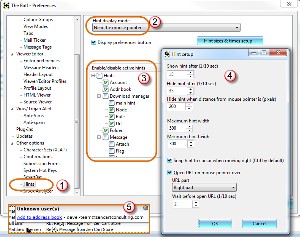 Other new features include the ability to enable or disable pop-up hints and actions. For example, hovering the mouse cursor over an address triggers a pop-up hint from The Bat offering to add the address to the user's address book. Users have complete control over whether the hints are displayed or not, how quickly they appear, how long they remain on the screen, and where they appear.
Other new features include the ability to enable or disable pop-up hints and actions. For example, hovering the mouse cursor over an address triggers a pop-up hint from The Bat offering to add the address to the user's address book. Users have complete control over whether the hints are displayed or not, how quickly they appear, how long they remain on the screen, and where they appear.
- From the Preferences panel, choose Hints.
- Set the display mode to Near Mouse Pointer.
- Select the hints you want to appear.
- Select the delay time, display time, and size of the hint box.
- Hints appear (in this case, I've hovered the mouse over an address and The Bat is offering to add the address to my address book.)
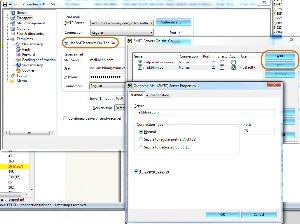 For advanced users, The Bat now supports more than one SMTP server. The SMTP server is what sends messages and, depending on where you are, you may need to switch among servers. Some people who have their own domains use the host's SMTP server but occasionally switch to their Internet service provider's SMTP server. Several reasons exist for doing this and the new capability means that the user no longer needs to edit one group of settings but only to switch between two existing setups.
For advanced users, The Bat now supports more than one SMTP server. The SMTP server is what sends messages and, depending on where you are, you may need to switch among servers. Some people who have their own domains use the host's SMTP server but occasionally switch to their Internet service provider's SMTP server. Several reasons exist for doing this and the new capability means that the user no longer needs to edit one group of settings but only to switch between two existing setups.

 A Superb E-mail Client that's Still Not for Everyone.
A Superb E-mail Client that's Still Not for Everyone.
Because of the enormous range of features, The Bat is the ideal e-mail application for power users. Version 5 is easy enough to set up and start using but less experienced users can become confused by all of the features. If you ever find yourself wishing that the e-mail program you're currently using could do something that it doesn't do, you're a candidate for The Bat. There's a 30-day free trial and a full new-user license is still only $45.
For more information, visit the RitLabs website.
Digital SLRs for Stills and Video
Listener James Pierson in Pittsburgh has some questions about digital single-lens reflex cameras on work sites for both stills and video. Although his questions were about a specific camera for a particular use, the questions are sufficiently general that I believe they'll be of interest to many people who are thinking about using a digital still camera for video.
JP: The company I work for has asked me to travel to some of our job sites this summer and shoot some video and still photos of our equipment in action. Since the immediate work zone is typically filled with high velocity projectiles I will need to use some sort of telephoto lens to get close-ups of the operation without destroying the lens. Probably from at least 100' away.
BB: A long lens is certainly helpful in a situation such as this because it keeps the photographic gear and the photographer out of harm's way. A long lens will also change the perspective significantly. Because you already subscribe to Lynda.com, you'll probably want to take a look at Ben Long's program on lenses—before you purchase the new gear if you have time but definitely before you head out to do the work.
JP: I have a budget of around $1000 for new equipment. I have heard lately that most modern DSLR cameras now shoot excellent video and that even some pro videographers are using them. I am leaning towards purchasing something like the soon to be released Canon T4i to do double duty for capturing still and video images.
BB: Two of my co-workers purchased Canon T3i cameras within the past year and both are delighted with the camera and with the quality of the images that they can create. One buyer is an experienced DSLR user and the other had never used a digital camera more advanced than the one in his phone.
The T4i will be the replacement for the T3i and it will definitely serve you well for still images and, if you can work within the constraints of the hardware, it will return outstanding video, too. The trouble is that I don't know right now what those constraints will be.
I would expect no changes from the T3i in the video section of the T4i: Full HD video is captured (1920 x 1080) and 29.97 frames per second. The files are saved in MOV format. The camera also offers 1280 x 720 and 640 x 480 video.
One of the most significant problems for SLRs as video cameras has been the lack of autofocus in video mode. With some Canon cameras it's possible to press a "focus" button but the result of trying to focus while shooting video will be far from acceptable. When DSLRs record video images, the mirror must be locked in the up position. As a result, the autofocus circuitry—housed in the top part of the camera—is blind. Autofocus is still possible but with a system that is much slower.
Attempting to focus while recording video will cause the lens to go out of focus so that it can seek the best possible focus. The image recorded during this operation will not be usable for that reason and because the built-in microphone will pick up the sound of the motor in the lens as it tries to focus the image.
The T4i will reportedly ship with a new 18-135mm image-stabilized lens that has a "silent" autofocus motor. If so, that would take care of the noise problem but it wouldn't address the out-of-focus condition as the lens seeks focus unless Canon has also found a way to improve the secondary focus system.
Having said all that, focus would not seem to be a problem for the use that you have in mind. You will be far enough away that minor movements won't have much of an effect on focus.
Another constraint that might be a problem for you is the inability to zoom in or out while recording. The zoom mechanism will work but two problems will immediately be obvious: The microphone will pick up the mechanical sound from the lens and the image will go out of focus. It is possible to construct a lens that will stay in focus during a zoom operation but not to construct a lens that will do that and be in the price range that most people can afford. So you'll need to treat the lens as if it's a fixed-length lens while recording.
A third consideration is the length of the scene you can record. The camera is doing a lot of work when its recording video and that translates to heat. Heat translates to lower video quality and the camera will take itself out of service when the heat reaches the danger zone. This could be a problem outside in the summer sun but you should still be able to record 10-15 minutes before you start seeing warnings in the viewfinder.
While the best possible solution would be two cameras, one for stills and one for video, that won't be possible in the $1000 range. For the use you've described, the T4i should do well.
JP: The primary purpose of the trip is to capture video but of course we also want to get some quality still images.
BB: For stills, I recommend shooting in raw mode and then using an application such as Adobe Lightroom 4 (or Photoshop or Photoshop Elements) to adjust the raw files.
The advantage of shooting in camera raw is that the file will contain every bit of detail the sensor was able to record and this gives you an enormous amount of latitude in how you use the resulting images.
The disadvantage of shooting in camera raw is that the raw files must be modified before they can be used. A raw file will appear dull and washed out as well as somewhat unsharp. Lightroom is what you'll use to process the files so that they'll look their best.
JP: I should add that I have never used a true DSLR camera before. I know that the lack of automatic settings will present a learning curve but I have always enjoyed reading the manual and figuring out how to work a new gadget.
BB: Some cameras come with a tiny (useless) printed manual and all the good stuff on a DVD. As I recall, my co-workers received full manuals with their T3i cameras and I would expect the T4i to come with a manual as well as a CD. Having the manual in digital form is handy but it doesn't replace a printed manual.
JP: Assuming you like the idea of using a DSLR for video, do you have any recommendations for lenses for both close up and achieving a close up view from about 100' away?
BB: The kit lens that comes with the basic T3i (18-55mm) wouldn't be adequate for your needs but the Canon kit camera that's comes with the 18-135mm lens would. Alternatively, you might consider buying just the camera body and matching it with a higher-quality used lens from a reputable store such as B&H Photo and Video in New York City. They currently have a Canon EF 70-300mm f/4-5.6 IS USM lens for about $400. If the T4i body is about the same price as the T3i body ($625), that would be just slightly above your price range.
Although the 70-300mm lens would work well for your longer distance work, it would prove to be too long for closer work. For that, you would need a lens that's more in the 30mm to 50mm range. There are lots of trade-offs when it comes to camera gear.
JP: I hear you talk about Adobe products all the time and I just did a trial of a bundle of the Elements versions of Photoshop and Premiere. Recently they offered a license for both for $75.00 so I jumped on that deal real fast. That should handle all the editing needs I will have.
BB: Yes, it will. Premiere Elements is an outstanding application. It's easy to use and is quite powerful.
"Internet Doomsday": Just Around the Corner!
On July 9, several hundred thousand people may suddenly discover that the Internet no longer works. At least that's what it sounds like on some radio and TV stations. In fact, the Internet will continue to work but several hundred thousand people may possess computers that cannot connect to websites or collect e-mail. Is your computer one of them? It's easy enough to find out but first let's consider the back story.
Last November the the FBI shut down a big botnet and arrested 6 Estonians who ran it. The botnet was being used to run a fraudulent business and software had been installed that forced the affercted computers to connect through the botnet's servers.
Being the nice guys that they are, the FBI replaced the botnet's command and control servers with servers of their own so that infected computers would still function properly. Had the FBI simply shut down the botnet command servers, hundreds of thousands of computers would have been disconnected.
The FBI doesn't want to go into the hosting business and has set July 9 as they day they'll shut down the servers. If your computer is still infected with what is called the DNS Changer malware, you won't be able to connect to the services you normally use.
In fact, the FBI had planned to shut down the servers in March and without giving much thought to those who would be inconvenienced but a federal judge ordered the agency to keep the servers running until July.
As it turns out, the infected computers aren't owned by unaware individuals who don't know any better than to click any link they're offered. Security experts say that half of all "Fortune 500" companies own computers that are infected.
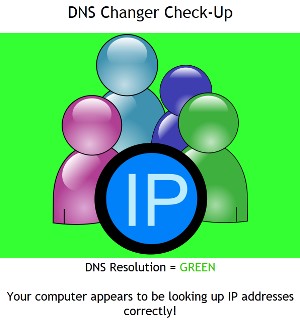 So you have until July 9th to find out if your computer is infected and then to disinfect it. The good news is that finding out if your computer is infected is easy and, if it is, removing the malware isn't difficult.
So you have until July 9th to find out if your computer is infected and then to disinfect it. The good news is that finding out if your computer is infected is easy and, if it is, removing the malware isn't difficult.
If you have an up-to-date protective application installed on your computer, it's likely that you're not affected or that the antivirus or antimalware application already found the threat and removed it. Norton Internet Security, for example, detects DNS Changer as Zlob or Tidserv.
To be certain, go to www.dcwg.org and click the Detect link. Or just go directly to www.dns-ok.us and you'll probably see an image with a green background. If you see a red background, you have a problem and you'll need to return to the DCWG site to disinfect the computer.
Short Circuits
Google Drive Isn't Free But it Might Be Reasonable
This week Google announced Google Drive, "a place where you can create, share, collaborate, and keep all of your stuff." Bear that "keep all your stuff" in mind as I prattle on about this new service. "Whether you’re working with a friend on a joint research project, planning a wedding with your fiancé, or tracking a budget with roommates," a Google blogster gushes, "you can do it in Drive. You can upload and access all of your files, including videos, photos, Google Docs, PDFs and beyond." Sounds good but this is Google so there's probably a catch, right?
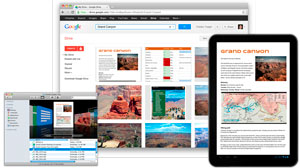 The idea is certainly valid: Store everything in a location where you can access it from your home PC, your office PC (assuming the network administrators allow it), a smart phone, a notebook, or a tablet—and make it possible to share specific documents or projects with others. So it sounds very good.
The idea is certainly valid: Store everything in a location where you can access it from your home PC, your office PC (assuming the network administrators allow it), a smart phone, a notebook, or a tablet—and make it possible to share specific documents or projects with others. So it sounds very good.
Specifically, the Google blogster suggests using Drive for collaboration because Google Docs is built in. That means you have the ability to work with others on a real-time basis.
Also, you can "store everything safely and access it anywhere." Drive works on Android devices as well as on PC and Mac computers. And Google is "working hard on a Drive app" for Apple's portable devices.
Still sounding great, isn't it? You can also search by keyword and filter by file type or owner. Drive has optical character recognition (OCR) built in so it can convert scanned images with text to text.
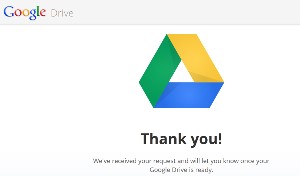 Store files totalling 5GB or less for free. These days, that's not a lot of space but you can increase the space to 25GB for $2.50 per month. Use the service a lot and your storage needs may well be measured in terabytes. Google will rent 1TB of storage for $50 per month, which is about the current going price for a 1TB disk drive.
Store files totalling 5GB or less for free. These days, that's not a lot of space but you can increase the space to 25GB for $2.50 per month. Use the service a lot and your storage needs may well be measured in terabytes. Google will rent 1TB of storage for $50 per month, which is about the current going price for a 1TB disk drive.
As with all things Google, you'll find yourself on a wait-list when you sign up.
When you upgrade to any paid account, your G-mail storage space also expands to 25GB, which should be enough to hold all of your e-mail messages for the foreseeable future.
Privacy concerns still exist with Google but, as usual, the company has built in enough features people will want that privacy concerns will probably be pushed to the back.
For more details, check out the Google Drive website.
It Was Never a Question of Whether
When an attack infected half a million or so Apple computers because of a long-known but unpatched flaw in Java, those of us who have tried for years to explain that all computers are vulnerable to some types of attacks felt somewhat vindicated. Not happy, because I don't wish a computer infection on anyone. But those Mac users who prepared themselves and their computers escaped.
Apple eventually released security patches and told users to install them as soon as possible but this week nearly 150 thousand machines are still infected. Worse, still, security firm Intego says that another variant (they've named in Flashback.S) is now active "in the wild".
Flashback.S doesn’t require a password to install. The new version can cover its own tracks well and thereby go unnoticed for longer. The malware places its files in the user’s home folder, at two distinct locations and avoids detection or sample recovery by deleting all files and folders in ~/Library/Caches/Java/cache to remove the applet from the infected Mac.
Apple hasn't had to deal with very much malware and has generally been slow to respond when threats arise. The first version of Flashback was used for what's called click fraud, in which compromised systems appear to click on advertising links so that advertisers are forced to pay for click-throughs that never occurred.
As long ago as 2008 some security analysts predicted that, as Apple's market share increased, fraudsters would be more likely to target the computers. Many Mac users scoffed at the thought that low market share was one reason that Macs seemed less likely to be afflicted by malware.
Apple's market share has grown from 5% or less in the 1990s to about 12% now. Microsoft systems still represent the far larger share of the market but nearly all Windows computers have antivirus and antimalware applications positioned between the operating system and the bad guys, something that, sadly, many Apple owners ignore when it comes to their computers.
Even sadder is the fact that Apple seems not to have bothered to consider the threats. Microsoft, battered and bruised, worked with vendors such as Symantec, Sophos, Eset, Kaspersky, Avast, AVG, Avira, McAfee, Bit Defender, and on and on. But Microsoft also developed its own security applications that are now built in to the operating system. In this race, Microsoft is the tortoise and Apple is the hare. And we all know how that worked out, don't we?
Wow! Stay Tuned for the News!
The next few weeks are going to be pretty exciting around here. I'm looking at several new applications and Photoshop plugins that I think you'll want to hear about. Looking ahead ...
- Adobe's Creative Suite 6 will ship next month. I've been working with the CS6 version of Photoshop for several weeks and should have preview copies of the rest of the suite soon. Overall, the applications are faster and address the latest technologies—whether on the Internet, in digital photography, on on screen. And Adobe will make it easier for those who work on both Windows and Mac computers.
- Lynda.com has some dynamite new programs that cover Adobe's CS6. I'm incredibly impressed by what the many authors who work to teach us how to use Adobe's many products have prepared introductory training sessions that are ready a month ahead of Adobe's release date.
- For the past several days I've been looking at Photoshop plugins from NIK—Viveza and Silver Efex Pro. As poweful as Photoshop is, it's even better when combined with plugins from vendors such as NIK and Alien Skin. And speaking of Alien Skin, the latest version of Eye Candy is something that serious amateurs and professionals will want to take a look at.
- When you buy a new computer from one of the big vendors, it will come with crapware. That's one of the reasons that I recommend dealing with local assmblers such as TCR Computers. But if you ignore my advice and buy from HP or Dell or Toshiba, I'll have some suggestions that will help you get rid of the craplets that these vendors install.
- Oh ... and near the end of this week, Adobe announced the availability of Lightroom 4.1 release candidate 2 on Adobe Labs. This update corrects issues reported from the initial Lightroom 4.0 release and Lightroom 4.1 Release Candidate but this update also allows Lightroom to support HDR (high dynamic range) files and provides new controls to correct for color fringing. This update also adds raw file format support for several new cameras including Canon EOS 60Da, Olympus OM-D E-M5, Samsung NX1000, and Sony Alpha NEX-VG20.
Those of some of the topics that are in the hopper now and will be waiting for you in future weeks—right here on TechByter Worldwide.



 The author's image: It's that photo over at the right. This explains why TechByter Worldwide was never on television, doesn't it?
The author's image: It's that photo over at the right. This explains why TechByter Worldwide was never on television, doesn't it?
